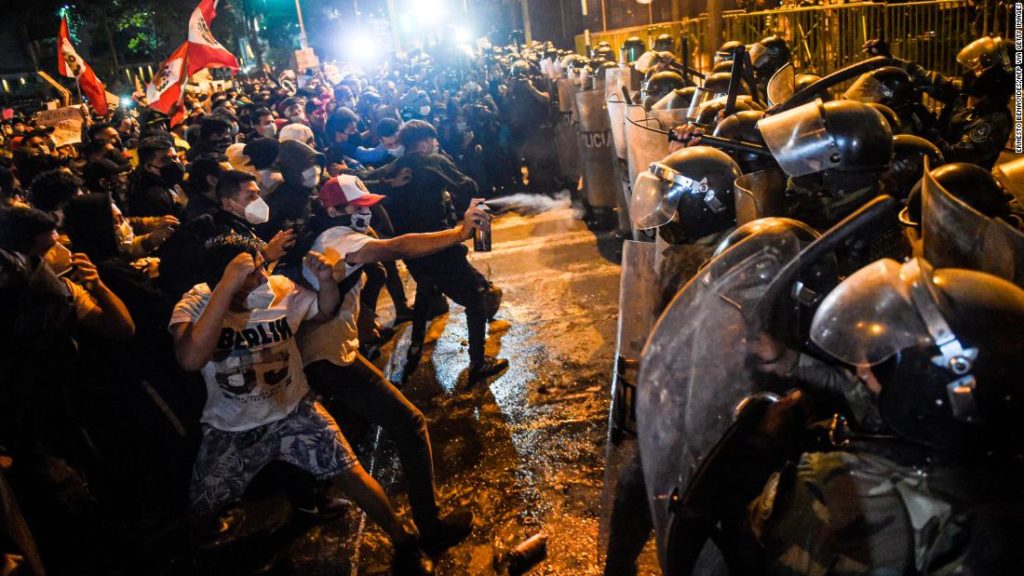Peru swore in its third president in just over a week on Tuesday, after the nation’s unstable political system crumbled spectacularly.
Sagasti will now have five months in office to steady the ship ahead of presidential elections in April 2021 amid a deadly pandemic and a public discontented with its bickering political class. Here’s what you need to know.
The current crisis is the culmination of four years of wrangling between multiple Peruvian presidents and the opposition-controlled Congress says Denisse Rodriguez-Olivari, a Peruvian political scientist at Humboldt University in Berlin, Germany.
Congress had put forward a huge number of motions against presidents and ministers, designed to stop the government from enacting policy, which Rodriguez-Olivari describes as its legislators’ “efforts to accentuate conflict.”
Keiko Fujimori, leader of the Popular Force party, lost the 2016 presidential election in a tight runoff, but her party held the most seats in Congress. “We are going to turn the proposals from our manifesto into laws,” she said, vowing to rule from Congress and setting up a fraught relationship with the president.
The power struggle was particularly contentious in the education arena, with legislators repeatedly putting forward motions to remove education ministers from their post and to slow reforms that would affect private universities.
On November 9, Congress voted to impeach Vizcarra following allegations of corruption related to construction projects approved when he was the governor of the Moquegua region in southern Peru from 2011 to 2014. Vizcarra has denied the allegations, but accepted the impeachment decision.
“History and the Peruvian people will judge,” he said in a speech following the impeachment vote.
As dictated by the constitution, Vizcarra was replaced by then-head of Congress Manuel Merino, who lasted just five days in the post before resigning under pressure from mass protests in which two people were killed and dozens more injured.
Sagasti, a 76-year-old legislator representing the Purple Party (Partido Morado), was then appointed by Congress to replace Merino, becoming Peru’s fourth president in less than five years. He takes power a time when the public has shown its willingness to take to the streets to express its disillusionment with the political class.
Why Peruvians protested
Sagasti’s appointment has gone some way to placate the public, as his party was the only one to vote as a bloc against impeaching Vizcarra.
In his first speech, the new president asked for “forgiveness in the name of the state” for the deaths of two protesters, Jack Bryan Pintado Sanchez and Jordan Inti Sotelo Camargo, and promised to support those who suffered injuries.
He also called on all of Peru to work together to create a “republic of equals.”
Peru’s voters are unlikely to be satisfied
One problem is that political parties form and dissolve at an alarming rate, and frequently put forward poor quality candidates.
“We end up voting for the least worst that we can find,” said Rodriguez-Olivari, who emphasized that voting is obligatory. “As a Peruvian I can’t remember the last time I voted for conviction instead of seeing what there is and making a choice.”
In his speech Sagasti, an engineer, academic and former World Bank official, himself recognized that much of the political class hasn’t “been up to the great challenges that we have faced.
Many previous rulers haven’t “been able to respond to the legitimate aspirations of the large majority of Peruvians,” he said.
Some citizens have called for a new constitution to update rules governing how presidents are removed, among other things.
And Rodriguez-Olivari says the rules governing political parties and candidates need to change too. But that’s a tall order when congress “has no incentive to make big reforms because they’d be shooting themselves in the foot.”
What comes next under a Sagasti presidency
Sagasti now takes over the reins of the country in an incredibly challenging period. Presidential and congressional elections are scheduled for April 2021, with Sagasti’s successor due to take over in July.
While progress in passing legislation may be limited due to the upcoming election, Sagasti has made a point of outreach to the public, having already visited some people injured by police and spoken to protesters as a conciliatory gesture.
His premiership could bring a measure of stability, but it will be hard to put the genie back in the bottle, warns Rodriguez-Olivari.
“Some people think that the protests are going to stop just because Merino left, but I think it has just blown the lid off a pressure cooker that has been building for years,” she said. “People have realized that by exerting some pressure for a few days they can achieve something.”
Expect Peruvians to be vigilant and vocal in making sure there is no rollback in progress on education reform and anti-corruption efforts, said Rodriguez-Olivari, as well as pushing for justice for human rights abuses against protesters and wider police reform. She descfribes Peruvian society as a kind of “citizenry 2.0” that is ready to push for change ahead of the country’s 200th anniversary of independence next year.
“Unfortunately it started with two deaths but I don’t think it’s going to stop now,” she said. “People are united in thinking that things can be done differently and they are willing to do whatever it takes.”
Reporting contributed by CNN’s Claudia Rebaza in London and Stefano Pozzebon in Bogota.
You may also like
-
UK coronavirus variant has been reported in 86 countries, WHO says
-
NASA technology can help save whale sharks says Australian marine biologist and ECOCEAN founder, Brad Norman
-
California Twentynine Palms: Explosives are missing from the nation’s largest Marine Corps base and an investigation is underway
-
Trump unhappy with his impeachment attorney’s performance, sources say
-
Lunar New Year 2021: Ushering in the Year of the Ox

